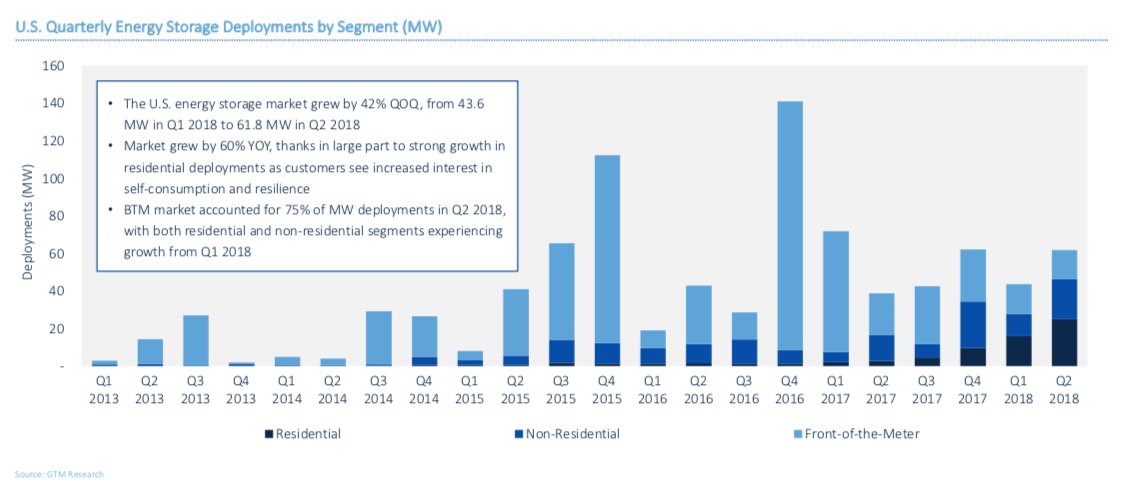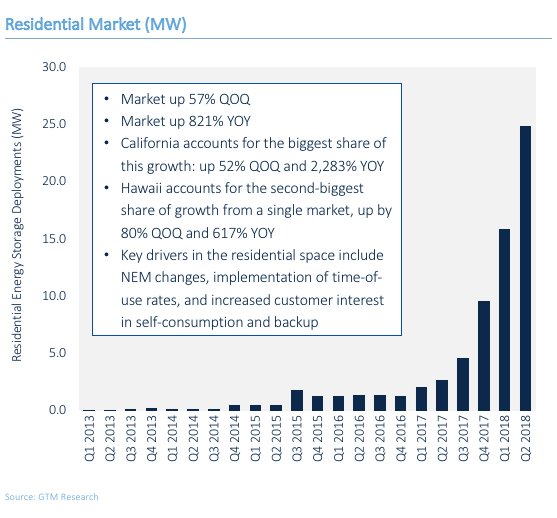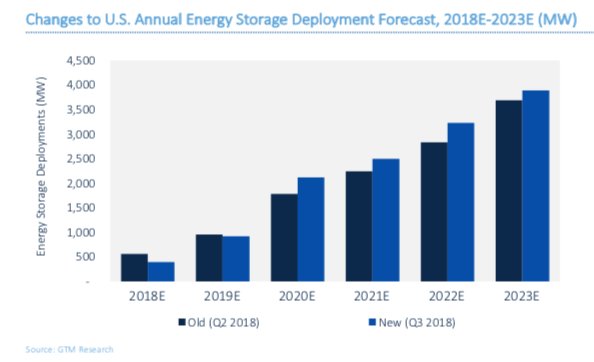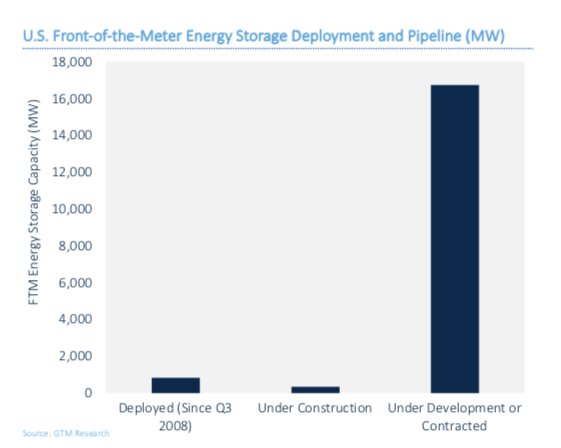Clean energy technologies have challenged U.S. utility planning for years. Recent numbers suggest residential energy storage growth may be the latest disruption to watch.
According to a new analysis from Wood Mackenzie Power & Renewables, the residential storage market grew tenfold from Q2 2017 to Q2 2018. Consumers are increasingly investing in storage for grid resilience, the economic benefits of self-consumption, and grid services.
John Farrell, director of Energy Democracy at the Institute for Local Self-Reliance (ILSR), says those types of numbers and the benefits of residential storage are a sign that utility control of the grid is shifting to empower consumers. Behind-the-meter storage systems have the capacity to give users more control over their own production and power usage.
“As the flow of power on the grid has shifted [from] one-way to two-way, so has the power to shape the electric grid’s future,” he wrote in a recent ILSR report on solar-plus-storage.
"What storage does is really just amplify the ability of the customers to get most, or all, of their electricity from their own generation, which just gives them really an unprecedented amount of leverage in their relationship with the utility," Farrell added in an interview.
“Smashed” records
Front-of-the meter storage has historically set the pace for deployment growth in the past. But in late 2017 and through Q2 2018, non-residential and residential systems began to emerge as significant growth markets.

Through Q2 2018 the overall storage market grew 60 percent over the same point last year and residential deployments fueled much of that growth.
According to WoodMac, second-quarter residential deployments, totaling 24.9 megawatts, “smashed” those in the previous quarter, which also set a record at 15.9 megawatts. Growth between Q1 2018 and Q2 topped out at 57 percent.

The increases were so great that Q2 alone had 31 percent more projects come online than did in the entirety of 2017.
Looking ahead, analysts project the residential market will reach 1 gigawatt of annual deployments in 2023. The 19 megawatts deployed in 2017 will grow to 82 megawatts by the end of this year. But those projects are dwarfed by the 1,089 megawatts WoodMac projects by the end of 2023.
Already-dominant states like California and Hawaii will continue to lead on new project deployments, with others such as Massachusetts and Arizona also making gains.
In the shorter term, though, WoodMac said deployments will be somewhat modulated due to supply constraints.
“Over the last few months, we’ve heard consistently from residential installers and distributors that they’re unable to receive residential storage systems in the quantities they ordered,” said Brett Simon, a senior energy storage analyst at WoodMac.
For that reason, analysts project market size to remain comparable to the first half of the year, rather than to show growth.
WoodMac analysts revised projections downward in 2018 and 2019, while deployments will be higher than previous forecasts between 2020 and 2023.

An expected 557 megawatts projected for the end of this year in WoodMac’s last storage report has now been downgraded to 393 megawatts. Next year’s forecast is a smaller shift, with a former projection of 956 megawatts bumped down to 923 megawatts. While supply issues have constrained the outlook in the near term, utility procurements have increased deployment forecasts through 2023.
"The real danger" is economics
Farrell argues in his report that the favorable economics of solar-plus-storage (falling battery prices have compelled much of the growth described above) will put pressure on many U.S. utilities.
"Increasingly, it's more of an economic decision," Farrell said. "[Customers] are not trying to compete with the utility; they're just saying, 'Oh, this makes financial sense for me.' I think that's the real danger for utilities."
According to Farrell’s analysis, a solar-plus-storage system can compete with electricity prices for 26 million customers in 19 states.
That’s based on a system including a 5-kilowatt solar array and a 7-kilowatt-hour Tesla Powerwall. According to WoodMac analysts, the average storage system ranges from 10 kilowatt-hours to 14 kilowatt-hours, with the 10-kilowatt-hour LG Chem Resu and the 14-kilowatt-hour Tesla Powerwall 2 dominating the market.
The benefits are most marked in states with significant solar resources, like Arizona, and states with high electricity prices like Connecticut (third highest in the country, according to this analysis), as well as states with both, like California.
Because of further expected declines in battery price, Farrell suggests the states where solar-plus-storage makes economic sense to consumers will become even more significant by 2022.
His map comparing prices in 2022 shows a “stunning contrast” to the first, according to his report. Consumers in states across the country, with wide-ranging historical electric prices, could reap benefits of storage systems attached to solar installations. By that year, Farrell says, almost half of all residential electricity customers — excluding those in four states — can access electricity from a solar-plus-storage system at comparable price to that of their utility rates.
Much of Farrell’s analysis hinges on further drops in battery prices. According to GTM Research, lithium-ion prices fell 65 percent between 2012 and 2016 while balance-of-systems declined 60 percent in that same timeframe.
A February WoodMac report on battery prices suggest looking ahead those precipitous declines will slow to 10 percent for batteries and 8 percent for balance-of-systems by the end of next year. WoodMac also projected that battery prices would fall 14 percent through 2018, but market shortages have since slowed those declines. Analysts increased their previous projection from $207 per kilowatt-hour for lithium-ion batteries to $225 per kilowatt-hour by the end of this year.
Increasing production in the next two years, with more capacity coming online, should alleviate that strain and push further declines. With those drops, Farrell’s scenario may still be attainable.
Storage hits the “major league”
While these price changes offer more choices to consumers, Farrell argues they present a serious threat to the utility business model.
“The combination of solar and energy storage won’t mean every customer is their own utility, but it reverses 100 years of top-down decision-making by granting customers much greater choice,” he writes in his report. “Almost no utility or utility regulator is adequately planning for this fundamental shift.”
Instead, Farrell said utilities have resisted the transition to distributed resources with “reactionary moves” or “gestures inadequate to address the magnitude of system change.”
While Farrell said he thinks utilities have been faster to catch on to the storage trend than they were with solar and have shown definite interest in the technology, he also points to the 60 gigawatts of gas power plant capacity that U.S. utilities have planned in the coming four years.
"I'm concerned that utilities are going to make investments in fossil fuels that make sense for the next five years, but then will be undercut by distributed sources," he said.
WoodMac takes a slightly different tack. Though the total capacity of storage projects utilities have proposed don’t come close to rivaling their commitments to gas, analysts write that the interest so far is a landmark for a fledgling industry — although the focus is largely on front-of-the meter projects rather than behind-the-meter ones.
“The past three months have redefined the scope and scale of utility energy storage procurement,” write WoodMac analysts. “Energy storage has moved up to the major league, and utilities are ready to put the emerging tech up to bat.”
Recently, PG&E, NV Energy, Xcel Energy and Hawaiian Electric announced projects that add up to almost 4 gigawatts of planned storage capacity over the next four years.
In Colorado, Xcel plans to procure 275 megawatts of solar-plus-storage through 2022. NV Energy in Nevada plans to invest an unprecedented $2 billion in 1,000 megawatts of solar plus 100 megawatts of storage. In California, PG&E’s record-breaking project at Moss Landing includes three installations from Tesla, Hummingbird and Vistra at over 500 megawatts combined.
Taken together, WoodMac called the utility procurement numbers “jaw-dropping.”
WoodMac’s total front-of-the-meter storage pipeline now tops 17,000 megawatts. While California is still the leader, with 47 percent of the pipeline compared to 67 percent in Q4 2017, other states are edging in as some California interconnections requests have been pulled.

That 17,000-megawatt total also doesn’t include many hybrid systems, like solar-plus-storage, because reports on interconnection queues make it difficult for analysts to discern the capacity of a project from storage and the capacity from solar.
The numbers could also change, though, as “many speculative projects in interconnection queues are unlikely to move forward." Analysts note that "the overall pipeline is much larger than projected U.S. deployments.”
Interconnection dates are also now moving into 2020 and 2021 because of supply constraints. Analysts said this has pushed some timelines back by six to nine months.
Still, WoodMac's outlook for utility involvement in storage is somewhat rosier than that of Farrell. Even with large-scale investments, he said, distributed storage can still pose a threat.
"What's challenging is, no matter how much utilities invest in storage themselves, it doesn't really change the economic picture for the customer — unless it means lower bills," Farrell said.
He said companies need to consider not just how the resource is useful to them but how it will shift the relationship with consumers.
"There's no doubt going to be a number of [utilities] that are going to seek policy changes to preserve their revenue streams. But I'm not sure they have a lot of good options in the long run." Farrell said. "What we need to figure out is: How do we price and value what these customers are doing?"
He said utilities should remain skeptical of investments in fossil fuel generation that will soon become stranded assets and that companies should focus more aggressively on distribution system planning and forecasting. He also pointed to market mechanisms that value storage's grid services, like managing peak demand, and allow smaller customers to aggregate their resources.
Those steps, he wrote, will aid the “transition from the dying utility distribution monopoly to a vibrant, democratic energy system where customers have the opportunity to choose distributed energy options that benefit themselves and the greater grid.”